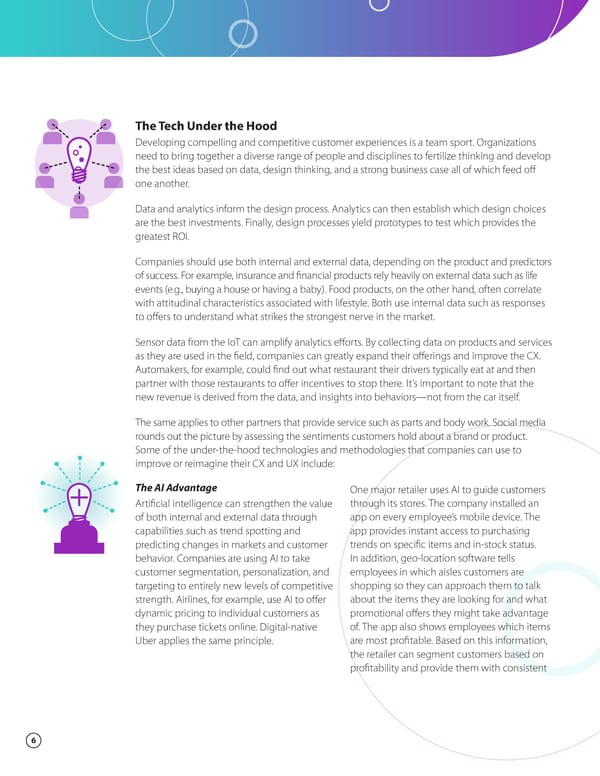The Tech Under the Hood Developing compelling and competitive customer experiences is a team sport. Organizations need to bring together a diverse range of people and disciplines to fertilize thinking and develop the best ideas based on data, design thinking, and a strong business case all of which feed off one another. Data and analytics inform the design process. Analytics can then establish which design choices are the best investments. Finally, design processes yield prototypes to test which provides the greatest ROI. Companies should use both internal and external data, depending on the product and predictors of success. For example, insurance and financial products rely heavily on external data such as life events (e.g., buying a house or having a baby). Food products, on the other hand, often correlate with attitudinal characteristics associated with lifestyle. Both use internal data such as responses to offers to understand what strikes the strongest nerve in the market. Sensor data from the IoT can amplify analytics efforts. By collecting data on products and services as they are used in the field, companies can greatly expand their offerings and improve the CX. Automakers, for example, could find out what restaurant their drivers typically eat at and then partner with those restaurants to offer incentives to stop there. It’s important to note that the new revenue is derived from the data, and insights into behaviors—not from the car itself. The same applies to other partners that provide service such as parts and body work. Social media rounds out the picture by assessing the sentiments customers hold about a brand or product. Some of the under-the-hood technologies and methodologies that companies can use to improve or reimagine their CX and UX include: The AI Advantage One major retailer uses AI to guide customers Artificial intelligence can strengthen the value through its stores. The company installed an of both internal and external data through app on every employee’s mobile device. The capabilities such as trend spotting and app provides instant access to purchasing predicting changes in markets and customer trends on specific items and in-stock status. behavior. Companies are using AI to take In addition, geo-location software tells customer segmentation, personalization, and employees in which aisles customers are targeting to entirely new levels of competitive shopping so they can approach them to talk strength. Airlines, for example, use AI to offer about the items they are looking for and what dynamic pricing to individual customers as promotional offers they might take advantage they purchase tickets online. Digital-native of. The app also shows employees which items Uber applies the same principle. are most profitable. Based on this information, the retailer can segment customers based on profitability and provide them with consistent 6
 Digital Transformation Starts with CX Page 7 Page 9
Digital Transformation Starts with CX Page 7 Page 9